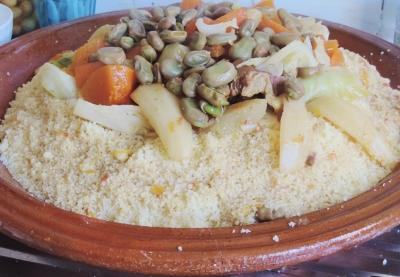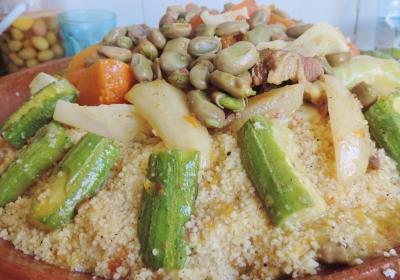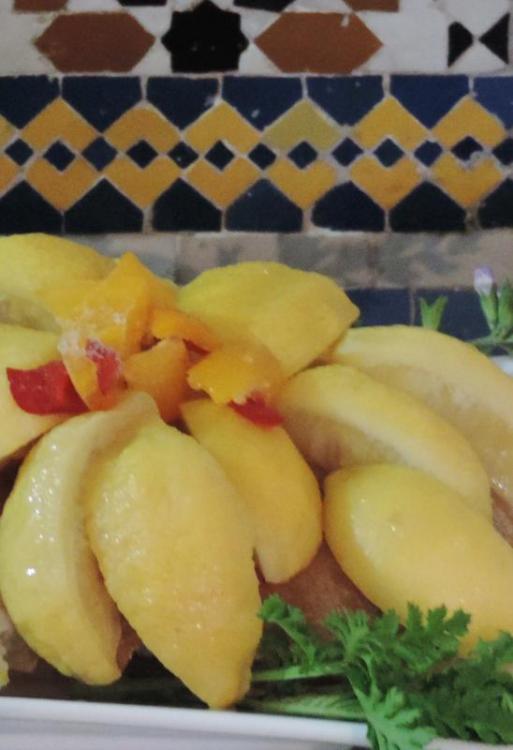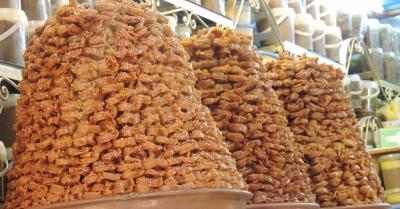
btissame
general member-
Posts
9 -
Joined
-
once you preserve lemons or any vegetable, olives, it goes a long way. but you can start using the preserved lemons after a month, the color is vibrant and the taste is quite fresh. My mom have them preserved for years too. Good idea to use safran and cardamon, I will try it... in my next post, I will do a traditional chicken with preserved lemons.
-
yes, 4Tbs of salt for each lemon and one at the bottom of the jar. The salt helps the lemon to release its juice. It's an easy way to make preserved lemons.
-
You cannot talk about Moroccan cuisine and not to mention preserved lemons in one of its dishes. This important ingredient of Moroccan cooking, usually used with chicken, seems to have different origins. Some referred it to Jews who have a slightly different procedure for preserving it, which involves the use of olive oil. Others claimed that the Persians brought the lemon to Greece, and their method is simple: Quarter the lemons, salt, and cover in lemon juice. The method I’m showing you today is used by my mom. It’s very simple and doesn’t require much time to do. Ingredients 5 lemons4 tablespoons for each lemon Preparation 1. Quarter the lemons from the top to within 1/2 inch of the bottom, put salt inside each lemon, and then reshape the fruit. 2. Place 1 tablespoon salt on the bottom of the jar. Pack in the lemons and push them down, adding more salt. Press the lemons down to release their juices and to make room for the remaining lemons. Leave some air space before sealing the jar. 3. Let the lemons ripen in a warm place, shaking the jar each day to distribute the salt and juice. Let ripen for 30 days. 4. To use, rinse the lemons, as needed, under running water, removing and discarding the pulp, if desired — and there is no need to refrigerate after opening. Preserved lemons will keep up to a year, and the pickling juice can be used two or three times over the course of a year.
-
Be inspired… They say, fes is the spiritual city of Morocco, home of the oldest university in the world, they also say, it’s the greatest city of high Islamic civilization. I say, Fes is a dream that takes you away in a magical voyage, the memory of a city founded by a dynasty. Have a tour on its ramparts, smell the old fragrances of al oud and musk, everything evolves in symbiosis, a mix of local knowledge and skills from artists and maalems are beautifully interwoven with a rich diverse inspiration from Andalusia, Orient and Africa. Fes, my city, my love, it’s your time to shine! and as Ramadan approaches, all Moroccan women are in culinary racing for the best Ramadan table. Sweets and cookies are prepared with lots of love. I'm sharing with you one of the famous sweets prepared during this fasting period. It's called Chebakkia. Here is the recipe: This recipe will make about 2 kg of chebbakia (approximatively 4.5 pounds). 4 cups flour1 tbs ground anise 1 tbs ground cinnamon 1/2 teaspoon salt 1/2 teaspoon saffron threadspinch of Arabic Gum (gum acacia, mastic) 1 bowl (about 250 g) of toasted sesame seeds1 egg 1/4 cup vinegar 1/4 cup orange flower water 2 tbs yeast dissolved in 1/4 cup warm water 1/4 cup melted butter1/4 cup olive oil ———————————————————————- about 3 lbs of honey 2 Tbs orange flower water 1 1/2 liters vegetable oil, for frying 1/2 cup toasted sesame seeds for decoratingPreparation: Make the Chebakia Dough Grind toasted sesame in a food processor until it becomes powder. Mix all the dry ingredients together: flour, ground sesame, anise, cinnamon, salt, saffron Arabic gum. Add the remaining ingredients and mix with your hands to form dough. Add more flour if necessary. Knead the dough for 10 minutes or in a mixer for five minutes. Divide the dough into four parts, shape each one into a smooth mound, and cover the dough and let it rest for 15 minutes. Roll and Cut the Dough & Fold the Chebakkia Lightly flour your work and start flattening the dough to a thin layer. Cut the dough into small rectangles and make 4 evenly spaced cuts without going through each cut. The rectangle should stay attached at the ends. It should have 5 attached strips. Hold the rectangle with your hand and try to thread in an alternative way. Then, with your hand try to gently turn the strips inside out until you have flower shape dough. Place the folded piece of dough on a tray. Repeat the process with the remaining rectangles. All the leftover dough should be reshaped into mounds again and repeat the same process. Cover the trays of folded dough with a towel until ready to fry. Frying the Chebakia Heat oil in a large, deep frying pan over medium heat. At the same time, heat the honey in a large pot, do not boil, add the orange flower water to the honey and turn off the heat. When the oil is hot, fry the chebakia in batches. Adjust the heat as necessary to slowly fry each batch of chebakia to a medium brown color. If the oil is too hot, this will cook chebakkia too fast and will look dark brown from the outside but still uncooked from inside. Glazing chebakkia Make sure chebakkia has a medium golden brown color, use a strainer to transfer them from the oil directly to the hot honey. Gently push down the chebakkia and soak them in the flavored honey, let them for 5 to 7 minutes. Once they absorb the honey, they will take on a nice shiny brown color. if you let them soak for a longer period, they will absorb more honey and will lose their crispiness. Gently transfer them to a large platter or tray, and sprinkle the centers with sesame. Enjoy!
-
- 1
-

-
Thank you so much for your comments. I have tons of recipes. I'm staring a new blog about Moroccan cuisine that I will lauch very soon before Ramadan. I will share the link with you all and hopefully will like it. I run cooking classes too and do Gourmet voyages and tours in my region fès, so you're welcome to visit Morocco and live the best culinary experience of your life, guaranteed...
-
Every region in Morocco has its own particularities and habits for breakfast. It is a ritual to be respected by each family, and as it differs slightly from city to city, it shares the same principle tasting known among all Moroccan: breakfast should be rich and never goes without a cup of fresh mint tea. The Fassi Breakfast from Fes example is known for its famous dish khlii (dried meat or Beef Jerky) served with scrambled eggs. The Berber breakfast considered as the main meal of the day, is based on organic ingredients such as wheat or barley: different kinds of handmade breads, cakes drizzled with honey and melted butter, virgin olive oil and black olives serve as the gourmet parts of every berber breakfast. Amlou (a mixture of almonds and Argan oil), also found in the South, is one of the main components of the Soussi breakfast (the region of Agadir, Ouarzazate ...). Natural ingredients and a hearty meal prepared by our moms with golden hands. For me, one of the things I like most is breakfast, and better it’s chic and we are in good company. We love to discover those beautiful views of the old medina in early morning, followed by a hearty breakfast with friends. Feeling the breezy air on your face while we serve you breakfast on a traditionally designed roof terrace or on verandas full of orange trees and roses. What can I say, talking about food in Morocco, is similar to a shimmery experience where aromas and flavors combine to offer your senses the most magical moments of your life. Come and enjoy Morocco, its food, people and where hospitality is always linked to its cuisine! It is truly a luxury gift from life…enjoy it too!





